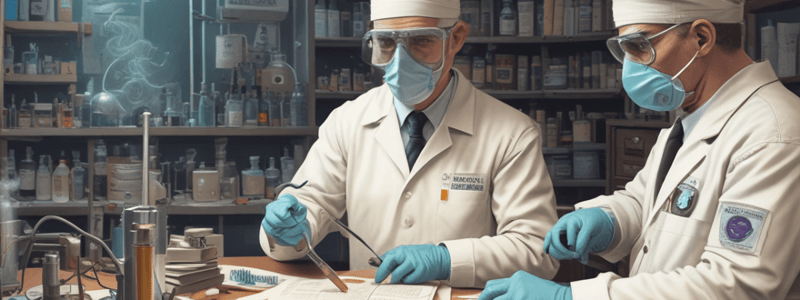Podcast
Questions and Answers
What is the role of the FSQM in relation to the LAPM?
What is the role of the FSQM in relation to the LAPM?
- The FSQM and LAPM are unrelated documents
- The FSQM is the policy to the LAPM's procedures (correct)
- The FSQM is the procedure to the LAPM's policy
- The LAPM is the policy to the FSQM's procedures
What are SOPs and Work Instructions used for?
What are SOPs and Work Instructions used for?
- To explain the structure of the laboratory
- To define the LAPM
- To provide detailed methods and procedures for specific tasks (correct)
- To outline the FSQM
What is a Deviation in the context of the laboratory?
What is a Deviation in the context of the laboratory?
- A new policy implemented by the laboratory
- A type of quality assurance review
- A request to depart from established procedures (correct)
- A type of quality control procedure
What happens when a Deviation is approved?
What happens when a Deviation is approved?
What is the purpose of a Laboratory Activity Review (LAR)?
What is the purpose of a Laboratory Activity Review (LAR)?
What is Nonconforming Work?
What is Nonconforming Work?
What is a Quality Assurance Review (QAR)?
What is a Quality Assurance Review (QAR)?
What is a Corrective Action Request (CAR)?
What is a Corrective Action Request (CAR)?
What is the purpose of a Risk and Opportunity Assessment (ROAR)?
What is the purpose of a Risk and Opportunity Assessment (ROAR)?
What is organized into three major categories?
What is organized into three major categories?
What is the primary purpose of forensic accreditation?
What is the primary purpose of forensic accreditation?
What is the frequency of the accreditation cycle?
What is the frequency of the accreditation cycle?
What is the definition of accreditation?
What is the definition of accreditation?
What is the purpose of Quality Assurance (QA)?
What is the purpose of Quality Assurance (QA)?
What is the purpose of Quality Control (QC)?
What is the purpose of Quality Control (QC)?
What is the purpose of validation?
What is the purpose of validation?
What is the purpose of performance checks?
What is the purpose of performance checks?
What is a controlled document?
What is a controlled document?
What is the purpose of the Forensic Science Quality Manual (FSQM)?
What is the purpose of the Forensic Science Quality Manual (FSQM)?
What is the organization that ANAB is a signatory of?
What is the organization that ANAB is a signatory of?
Flashcards are hidden until you start studying
Study Notes
Forensic Accreditation
- Forensic accreditation provides confidence in testing, inspections, and calibrations for use in criminal and civil proceedings
- Accreditation demonstrates that crime laboratories, law enforcement agencies, and medical examiners' offices conduct activities in conformance with internationally recognized standards
Definition of Accreditation
- Accreditation is an assessment of an agency's technical qualifications and competence for conducting specific testing, calibration, and/or inspection activities
- Accreditation is within the scope of ISO/IEC 17025 or ISO/IEC 17020 and any relevant field-specific standards
History of Accreditation
- FDLE first received accreditation in 1990 from ASCLD-LAB
- Reaccreditation assessments occurred every five years, and the first international accreditation happened in 2010
- ASCLD-LAB merged with ANAB in 2016
- Accreditation cycle is now every four years (2019, 2023, 2027)
Accreditation Cycle
- Year 0: Initial accreditation assessment
- Year 1: Offsite quality document review
- Year 2: Surveillance visit for targeted disciplines/quality review
- Year 3: Offsite quality document review
- Year 4: Full reaccreditation assessment
ANAB Accreditation
- ANAB is accredited by the International Laboratory Accreditation Cooperation (ILAC) and has a Mutual Recognition Arrangement (MRA) in both InterAmerican Accreditation Cooperation (IAAC) and Asia-Pacific Accreditation Cooperation (APAC)
Layers of Quality
- International Standards: ISO 17025:2017
- National Forensic Standards: ANAB AR 3125:2023
- FDLE Laboratory Standards: Forensic Science Quality Manual, Laboratory Administrative Procedures Manual
- Discipline Standards: Standard Operating Procedures & Work Instructions
Quality Assurance (QA)
- Planned and systematic actions to provide sufficient confidence that the laboratory's product or service will satisfy the requirements of quality
- Examples: laboratory policy & procedure, training, competency and certification program, continuing education, proficiency testing, and performance monitoring program
Quality Control (QC)
- Internal activities to monitor the quality of data or service being provided compared to specific criteria
- Examples: reagent checks, instrument calibrations and controls checks, verifications, trend monitoring, technical and administrative reviews of each case file
Validations
- Evaluation of new technical procedures, software, and analytical instruments for forensic casework
- Process of performing a set of experiments to establish the efficiency and reliability of a technique
- Examples: precision, limit of detection/quantitation, specificity, carryover, stability, reproducibility, determination of measurement uncertainty
Performance Checks
- Modifications to existing procedures, updated versions of software, and updated analytical instrument models are verified and suitable for use in casework
- Examples: new instrumentation already in use at the laboratory, moving an existing procedure to a different instrument, updated revision of software or operating system
Controlled Documents
- Documents issued and distributed in a trackable manner
- Examples: FSQM, LAPM, discipline SOPs, evidence submission manual, new member training manual, CLA training manual, FT training manual, case worksheets
Forensic Science Quality Manual (FSQM)
- States how the FDLE laboratory system fulfills the accreditation standards detailed in the ISO 17025 standards and AR 3125 accreditation requirements
- Structured to directly correlate to the standards: structural requirements, resource requirements, process requirements, management system requirement
Laboratory Administrative Procedures Manual (LAPM)
- Defines the approved way of performing laboratory tasks with statewide consistency
- Organized in three major categories: casework practices, quality practices, business practices
Standard Operating Procedures (SOPs) and Work Instructions
- Discipline-specific methods and procedures
- Found on the FDLE Forensic Services webpage
- Examples: specific discipline requirements for the analysis, instrumental maintenance, quality control procedures, extraction procedures, abbreviations, chemical reagent preparations, and other tasks
Deviations
- Departing from the established course or accepted standard listed in FSQM, LAPM, or discipline SOP
- Deviation requests are submitted prior to work being performed on the evidence
Nonconforming Work
- Occurs when there is an unexpected discrepancy or departure from the policies or procedure of the management system or to technical operations
- Each analyst is responsible for their own technical review and verification prior to submitting a case for review
Laboratory Activity Review (LAR)
- Used to review deviations or potential nonconforming work
- Completed by CLAS and forwarded to both COFS & AFQM / FQM for review
- Either a correction is granted or further investigation is needed based on significance, risk levels, and impact to current and previous casework
Quality Assurance Review (QAR)
- Used to document the parameters and findings of the investigation
- The results of the investigation are reviewed by the COFS and FQM/AFQM
- Correction action may be needed as determined by quality management based on the investigation
Corrective Action Request (CAR)
- Used to document the after-action of a quality review
- Corrective action is specific to each incident and may vary
- Examples: additional training or competency testing, additional validations or performance check, recall of casework for additional testing
Risk and Opportunity Assessment (ROAR)
- Way to prevent or reduce undesirable events, results, or potential failures while identifying improvements that help the laboratory better achieve its objectives
Studying That Suits You
Use AI to generate personalized quizzes and flashcards to suit your learning preferences.


